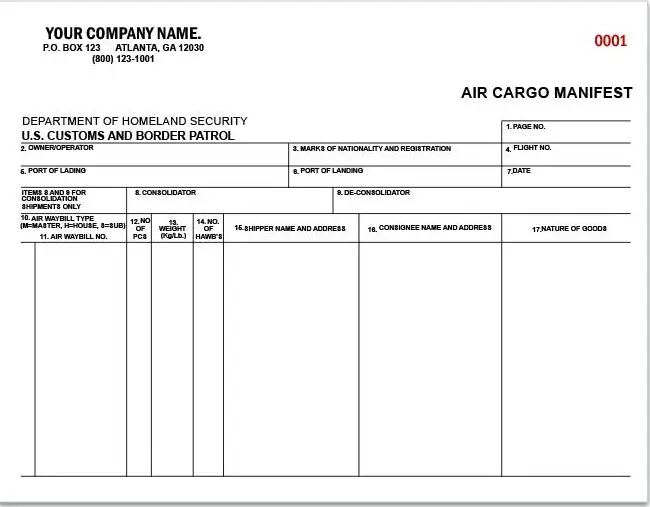In international logistics, the cargo manifest is a crucial shipping document that ensures your freight is moving smoothly and your paperwork is in order. It lists every item loaded onto a vessel, aircraft, or truck, organized by destination and linked to individual bills of lading. Customs authorities rely on this document to verify the cargo against official records. Any mismatch could result in delays, fines, or worse, your goods being stuck in port.
Types of cargo manifests
Sea cargo manifest
A sea manifest cargo lists all containers or goods loaded onto a vessel, grouped by port of destination. For example, a shipment departing from Shenzhen might carry containers bound for destinations such as Singapore, Hamburg, and Los Angeles. Each container will appear on the manifest with its corresponding bill of lading number, description, and cargo weight.
This document helps port authorities and customs officials efficiently process and clear each segment of the shipment.
Dangerous cargo manifest
When shipping hazardous materials such as lithium batteries or vape products, a dangerous good manifest is mandatory. It must comply with IATA (air) or IMO (sea) regulations, depending on the mode of transport. This document details hazard classifications, UN numbers, emergency handling instructions, and packaging specs.
Oil cargo manifest
An oil manifest applies specifically to crude oil or refined petroleum products. It records the volume (usually in barrels or metric tons), product specifications, and loading or discharge ports.
Additional manifest types
Some shipments require more specialized documentation. The OLI cargo manifest, for example, tracks consolidated goods under a single master bill of lading. It is ideal for groupage or LCL shipping.
In digital customs environments, a cargo shipping manifest document may exist entirely in electronic form, integrated with clearance systems for faster processing and reduced paperwork.
Example of cargo manifest form

How to fill out a manifest in shipping
1. Start with basic shipment details
Include the carrier name, voyage or flight number, date of departure, and port or airport of origin. This anchors the manifest to a specific leg of the shipment.
2. Add consignee and shipper information
List both the shipper and consignee details. It includes names, contact info, and addresses.
3. List each item of cargo
For every package, pallet, or container, provide:
- Description of goods
- Quantity and packaging type (e.g., 20 cartons)
- Gross weight and volume
- Country of origin
- Destination port or airport
- Related bill of lading or airway bill number
This section makes up the core of your manifest cargo details.
4. Declare special cargo
If you’re transporting hazardous materials, attach a DG manifest segment. It must include:
- UN number
- Proper shipping name
- Hazard class
- Packaging group
- Emergency contact information
5. Sign and submit
Once complete, the authorized carrier or freight agent must sign the cargo manifest form. Today, most ports and airports require digital submission through customs platforms or e-manifest systems for faster processing.
Cargo manifest requirements across countries
United States (CBP – U.S. Customs and Border Protection)
The United States requires carriers or importers to file an electronic cargo manifest using systems like AMS for ocean freight. For air shipments, it uses an Automated Commercial Environment (ACE) system.
- Sea freight manifest: Must be filed at least 24 hours before loading at the foreign port.
- Air freight manifest: Requires pre-arrival submission, typically 4 hours prior to the aircraft arriving in the U.S.
Missing or inaccurate entries can trigger exams, detentions, or penalties.
European Union (ICS2 – Import Control System 2)
EU member states use ICS2 to conduct security pre-screening for all inbound cargo. Under ICS2, air cargo manifests are subject to stricter screening. Moreover, advanced data filing is now mandatory for postal and express operators.
Each EU country may impose additional local procedures in addition to the centralized system. Therefore, working with an experienced freight forwarder can help navigate these layered requirements.
Middle East (e.g., UAE, Saudi Arabia)
GCC nations rely on platforms like Dubai Trade and Saudi Arabia’s Bayan to process electronic cargo manifest submissions. Meanwhile, oil freight manifests are subject to strict oversight due to environmental and trade compliance requirements.
Australia & New Zealand
These countries enforce strict biosecurity and import rules.
- Manifest cargo entries must include specific, itemized descriptions—not vague terms like “equipment” or “goods.”
- List items such as wood packaging, plants, or food clearly to avoid quarantine or inspection.
- Australia requires pre-arrival reporting for all inbound air and sea cargo via its Integrated Cargo System (ICS).
Conclusion
Each country defines its version of a “complete” cargo manifest, with variations in format, submission method, and timing. But across the board, three things remain essential: accuracy, timeliness, and compliance.
At ASLG, we help shippers stay ahead of country-specific cargo documentation rules. From air cargo manifest forms to essential documents filings, we ensure everything is in place so your goods don’t get stuck at the border.




